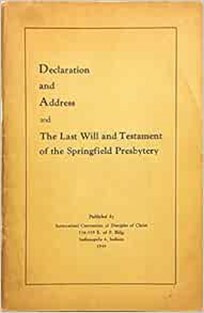Did You Know... Week 1
Did You Know… that the Christian Church (Disciples of Christ) almost didn’t exist?
In 1801, Barton Stone and five other Presbyterian ministers split from the Kentucky Synod of the Presbyterian church to form their own independent Springfield Presbytery. They had been inspired by an event that had occurred recently at Stone’s congregation in Cane Ridge, KY. Thousands of people, representing different Christian denominations, met together for a weekend of fellowship, preaching, and the Lord’s Supper. Prior to that time, Presbyterians only served communion to other Presbyterians. But over that weekend, Stone watched as the Holy Spirit brought people together for worship and inspiration, regardless of their denominational affiliation. When Sunday arrived and it came time to serve communion, Stone felt it was impossible to withhold the Bread and Cup from the Methodists, Lutherans, and Baptists who were also there, since they had been moved by the same Holy Spirit as the Presbyterians were. He broke with the tradition of his Presbyterian Church and served communion to all who were gathered.
Shortly thereafter, he and the other like-believing Presbyterian pastors formed their own Springfield Presbytery, which focused on the unity of all Christians based on a shared belief in Jesus as the Christ. Unity, Stone would say, should be our “polar star” that must guide us in all things. Over the next few years, 15 congregations in Kentucky joined the movement. But then, not even three years later, the six pastors – led by Stone – published a document called “The Last Will and Testament of the Springfield Presbytery.” They wrote: “We will, that this body die, be dissolved, and sink into union with the Body of Christ at large; for there is but one body, and one Spirit, even as we are called in one hope of our calling.” They disbanded the very thing they had created, believing that creating a new church was not bringing people together in Christian unity, but rather adding another layer of division. They envisioned that all congregations would be independent, only refer to one another as “Christians,” and focus on what they had in common with other congregations and not what was different among them.

Barton Stone and others would continue this independent “Christian” movement for many years until one day joining with Alexander Campbell (who was leading a movement calling themselves “Disciples”) to form the Christian-Disciples Movement. Though this would one day become the Christian Church (Disciples of Christ), it never lost the desire to promote Christian unity and to emphasize what we have in common with other Christians and not on what distinguishes us from them.
- Blessings, Michael
